7.1数组
l 数组是多个相同类型数据的组合,实现对这些数据的统一管理
l 数组中的元素可以是任何数据类型,包括基本数据类型和引用数据类型
l 数组属引用类型,数组型数据是对象(object),数组中的每个元素相当于该对象的成员变量
7.2一维数组
public class TestArray {
public static void main(String[] args) {
int i1;
i1 = 12;
boolean b = true;
//1.如何定义一个数组
//1.1数组的声明
String[] names;
int scores[];
//【注】Java语言中声明数组时不能指定其长度(数组中元素的数), 例如: int a[5]; //非法
//1.2初始化
//第一种:静态初始化:初始化数组与给数组元素赋值同时进行。
names = new String[]{"周爽","郭强强","俞乾龙"};
//第二种:动态初始化:初始化数组与给数组元素赋值分开进行。
scores = new int[4];
//2.如何调用相应的数组元素:通过数组元素的下角标的方式来调用。
//下角标从0开始,到n -1 结束。其中n表示的数组的长度。
scores[0] = 87;
scores[1] = 89;
scores[3] = 98;
//3.数组的长度:通过数组的length属性。
System.out.println(names.length);//3
System.out.println(scores.length);//4
//4.如何遍历数组元素
for(int i = 0;i < names.length;i++){
System.out.println(names[i]);
}}}
//声明数组的错误写法:
1)String[] names = new String[5]{"AA","BB","CC"};//右边[ ]中的5不用写了
2)int i[10];//正确写法:int i[] = new int[10];
3)int i = new int[];//[ ]中要指明数组长度
【注】不管是动态还是静态初始化数组,一定在创建的时候,就指明了数组的长度!每个数组都有一个属性length指明它的长度,例如:a.length 指明数组a的长度(元素个数)。数组一旦初始化,其长度是不可变的。
关于数组元素的默认初始化值
//关于数组元素的默认初始化值:
1)byte short int long 而言:0
2)float double 而言:0.0
3)char而言:空格
4)boolean而言:false
5)引用类型变量而言:null
//初始化时的一些其他正确写法:
1.Int[] myInt; myInt = new int[]{1,2,3};
2.int[] myInt = {1,2,3};
// 错误:
int myInt;
myInt = {1,2,3};
//数组的内存结构

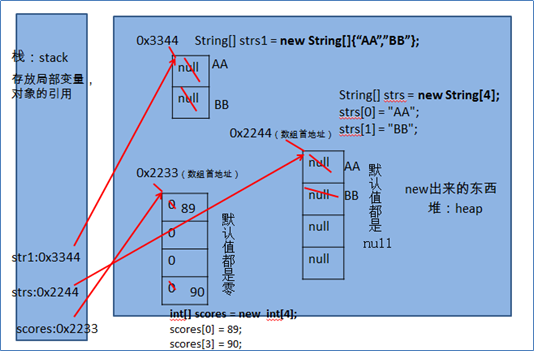
【练习1】
/*
1.(1)定义类Pritimive,在类中定义一个有3个元素的boolean类型的数组t作为其成员变量。数组元素未赋值。
定义类TestPritimive,在TestPritimive的main()方法中创建Pritimive对象d,输出其成员变量t的三个元素值。
练习目的:检验基本数据类型数组创建时的自动赋值。
(2)给对象d的成员变量t赋值为{true,true,true},并输出t的三个元素值。
*/
public class TestPritimive {
public static void main(String[] args) {
//创建Pritimive的对象d
Pritimive d = new Pritimive();
//遍历d的数组元素
for(int i = 0;i < d.t.length;i++){
System.out.println(d.t[i]);
}
//给d的数组元素重新赋值
d.t[0] = true;
d.t[1] = true;
d.t[2] = true;
for(int i = 0;i < d.t.length;i++){
System.out.println(d.t[i]);
}
}
}
class Pritimive{
boolean[] t = new boolean[3];
}
【练习2】
/* 从键盘读入学生成绩,找出最高分,并输出学生成绩等级。
成绩>=最高分-10 等级为’A’
成绩>=最高分-20 等级为’B’
成绩>=最高分-30 等级为’C’
其余 等级为’D’
提示:先读入学生人数,根据人数创建int数组,存放学生成绩。
*/
import java.util.Scanner;
public class TestStudentScore {
public static void main(String[] args) {
//1.创建Scanner的对象,并从键盘获取学生的个数n
Scanner s = new Scanner(System.in);
System.out.println("请输入学生的个数:");
int count = s.nextInt();//count用来记录学生的个数
//2.根据输入的学生的个数n,创建一个长度为n的int型的数组
int[] scores = new int[count];
int maxScore = 0;
//3.依次从键盘获取n个学生的成绩,并赋给相应的数组元素,并获取n个学生中的最高分
System.out.println("请输入" + count + "个成绩:");
for(int i = 0;i < scores.length;i++){
int score = s.nextInt();//依次从键盘获取学生的成绩
scores[i] = score;
if(scores[i] > maxScore){
maxScore = scores[i];
}
}
//4.遍历学生成绩的数组,并根据学生成绩与最高分的差值,赋予相应的等级,并输出
System.out.println("最高分为:" + maxScore);
for(int i = 0;i < scores.length;i++){
char level;
if(scores[i] >= maxScore - 10){
level = 'A';
}else if(scores[i] >= maxScore - 20){
level = 'B';
}else if(scores[i] >= maxScore - 30){
level = 'C';
}else{
level = 'D';
}
System.out.println("student " + i + " score is " + scores[i] + " grade is " + level);
}}}
//输出效果:
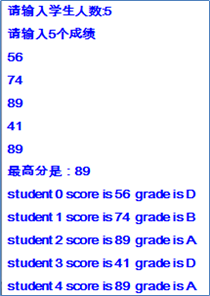
7.3二维数组

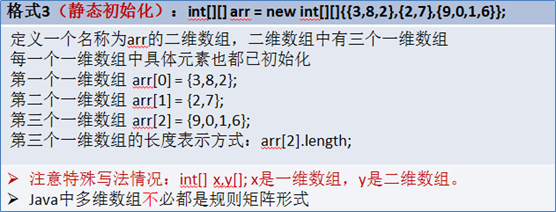
public class TestArray2 {
public static void main(String[] args) {
int[] scores1 = new int[10];
int[][] scores2;
String[][] names;
//1.二维数组的初始化
scores2 = new int[][]{{1,2,3},{3,4,5},{6}};//静态初始化
names = new String[6][5];//动态初始化的方式一
names = new String[6][];//动态初始化的方式二
names[0] = new String[5];
names[1] = new String[4];
names[2] = new String[7];
names[3] = new String[5];
names[4] = new String[8];
names[5] = new String[5];
//错误的初始化方式
//names = new String[][];
//names = new String[][5];
//2.如何来引用具体的某一个元素
int[][] i = new int[3][2];//int[] i[] = new int[3][2];
i[1][0] = 90;
i[2][1] = 100;
//3.数组的长度
//二维数组的长度:length属性
System.out.println(i.length);//3
//二维数组中元素的长度
System.out.println(i[0].length);//2
System.out.println(names.length);//6
System.out.println(names[4].length);//8
System.out.println();
//4.如何遍历二维数组
for(int m = 0;m < scores2.length;m++){//控制行数
for(int n = 0;n < scores2[m].length;n++){
System.out.print(scores2[m][n] + " ");}
System.out.println();}
//5.内存结构
int[] x,y[];
//int[] x;//一维
//int[] y[];//二维
y = new int[3][2];
x = y[0];
x[0] = y[1][2];}}

【练习1】

public class TestGetSum {
public static void main(String[] args) {
int[][] m = new int[][]{{3,8,2},{2,7},{9,0,1,6}};
int sum = 0;
for(int i = 0;i < m.length;i++){
for(int j = 0;j < m[i].length;j++){
System.out.print(m[i][j] + " ");
sum += m[i][j];
}
System.out.println();
}
System.out.println("总和为:" + sum);
}
}
【练习2】
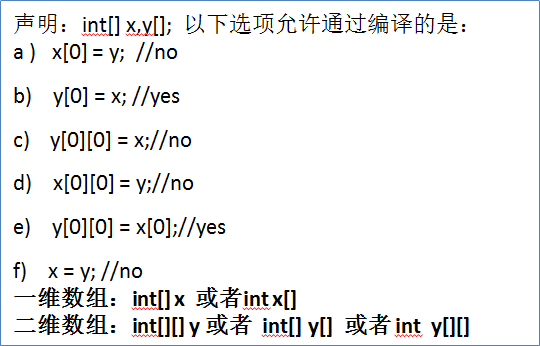
【练习3】

public class TestYangHui {
public static void main(String[] args) {
int[][] yangHui = new int[10][];
//1.初始化二维数组
for(int i = 0;i < yangHui.length;i++){
yangHui[i] = new int[i + 1];
}
//2.显式的为二维数组的每个元素赋值
for(int i = 0;i < yangHui.length;i++){
for(int j = 0;j < yangHui[i].length;j++){
yangHui[i][0] = yangHui[i][i] = 1;
if(i > 1 && j > 0 && j < i){
yangHui[i][j] = yangHui[i-1][j] + yangHui[i-1][j-1];
}
}
}
//遍历二维数组
for(int i = 0;i < yangHui.length;i++){
for(int j = 0;j < yangHui[i].length;j++){
System.out.print(yangHui[i][j] + " ");
}
System.out.println();
}
}
}
7.4数组的常见异常
public class TestException {
public static void main(String[] args) {
//1.数组下标越界的异常:java.lang.ArrayIndexOutOfBoundsException
int[] i = new int[10];
i[0] = 90;
i[10] = 99;
for(int m = 0;m <= i.length;m++){
System.out.println(i[m]);
}
//2.空指针的异常:NullPointerException
//第一种:
boolean[] b = new boolean[3];
b = null;//b指向的地址变成null了,找不到b[0]了
System.out.println(b[0]);
//第二种:
String[] str = new String[4];
//str[3] = new String("AA");//str[3] = "AA";//没有这两句中的一句,就会出现异常
System.out.println(str[3].toString());
//第三种:
int[][] j = new int[3][];
j[2][0] = 12;
}
}
7.5数组的常用算法问题
1.求数组元素的最大值、最小值、平均数、总和等
【练习】定义一个int型的一维数组,包含10个元素,分别赋一些随机整数,然后求出所有元素的最大值,最小值,平均值,和值,并输出出来。
【代码】
public class TestArray3 {
public static void main(String[] args) {
int[] arr = new int[] { 12, 43, 9, 0, -65, -99, 100, 9 };
// 最大值
int max = arr[0];
for (int i = 1; i < arr.length; i++) {
if (max < arr[i]) {
max = arr[i];}}
System.out.println("数组的最大值为:" + max);
// 最小值
int min = arr[0];
for (int i = 1; i < arr.length; i++) {
if (min > arr[i]) {
min = arr[i];
}
}
System.out.println("数组的最小值为:" + min);
// 总和
int sum = 0;
for (int i = 0; i < arr.length; i++) {
sum += arr[i];
}
System.out.println("总和为:" + sum);
// 平均数
int avg = 0;
avg = sum / arr.length;
System.out.println("平均值为:" + avg);
}
}
【输出函数的快捷键】syso +alt+/
2.数组的复制、反转
【练习】
使用简单数组
(1)创建一个名为TestArray的类,在main()方法中声明array1和array2两个变量,他们是int[]类型的数组。
(2)使用大括号{},把array1初始化为8个素数:2,3,5,7,11,13,17,19。
(3)显示array1的内容。
(4)赋值array2变量等于array1,修改array2中的偶索引元素,使其等于索引值(如array[0]=0,array[2]=2)。打印出array1。
思考:array1和array2是什么关系?array2 = array1:表示将array1的地址值赋给了array2
拓展:修改题目,实现array2对array1数组的复制
【代码】修改array2的时候,array1也被改变了,类似“快捷方式”
public class TestArray {
public static void main(String[] args) {
int[] array1, array2;
array1 = new int[] { 2, 3, 5, 7, 11, 13, 17, 19 };
// 遍历array1
for (int i = 0; i < array1.length; i++) {
System.out.print(array1[i] + " ");
}
System.out.println();
System.out.println(array1);
array2 = array1;
System.out.println(array2);
// 修改array2
for (int i = 0; i < array2.length; i++) {
if (i % 2 == 0) {
array2[i] = i;
}
}
// 遍历array1
for (int i = 0; i < array1.length; i++) {
System.out.print(array1[i] + " ");
}}}
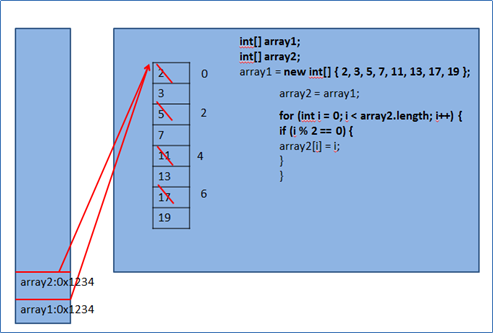
正确的复制方式:
public class TestArray3 {
public static void main(String[] args) {
int[] arr = new int[] { 12, 43, 9, 0, -65, -99, 100, 9 };
// 数组的复制
int[] arr1 = new int[arr.length];
for (int i = 0; i < arr1.length; i++) {
arr1[i] = arr[i];
}
// 数组元素的反转(逆序)
//方法一:
for(int i = 0;i < arr.length/2;i++){
int temp = arr[i];
arr[i] = arr[arr.length-1 - i];
arr[arr.length - 1 - i] = temp;
}
//方法二:
for (int x = 0, y = arr.length - 1; x < y; x++, y--) {
int temp = arr[x];
arr[x] = arr[y];
arr[y] = temp;
}
System.out.println("反转以后:");
// 遍历
for (int i = 0; i < arr.length; i++) {
System.out.print(arr[i] + " ");
}}}
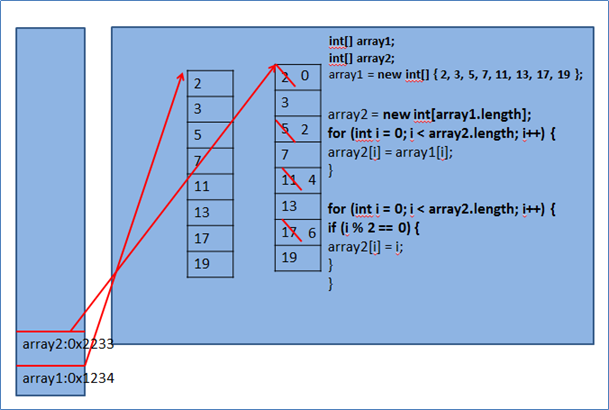
3.数组元素的排序(面试前看一看)
l 插入排序
- 直接插入排序、折半插入排序、希尔(Shell)排序
l 交换排序
- 冒泡排序、快速排序(或分区交换排序)
l 选择排序
- 简单选择排序、堆排序
l 归并排序
l 基数排序
public class TestArray3 {
public static void main(String[] args) {
int[] arr = new int[] { 12, 43, 9, 0, -65, -99, 100, 9 };
// 使用冒泡排序使数组元素从小到大排列
for (int i = 0; i < arr.length - 1; i++) {
for (int j = 0; j < arr.length - 1 - i; j++) {
if (arr[j] > arr[j + 1]) {
int temp = arr[j];
arr[j] = arr[j + 1];
arr[j + 1] = temp;}
}
}
//使用直接选择排序使数组元素从小到大排列
for(int i = 0; i < arr.length - 1; i++){
int t = i; //默认i处是最小的
for(int j = i;j < arr.length;j++){
//一旦在i后发现存在比其小的元素,就记录那个元素的下角标
if(arr[t] > arr[j]){
t = j;}}
if(t != i){
int temp = arr[t];
arr[t] = arr[i];
arr[i] = temp;}
}
Arrays.sort(arr);
System.out.println("排序以后:");
// 遍历
for (int i = 0; i < arr.length; i++) {
System.out.print(arr[i] + " ");
}}}